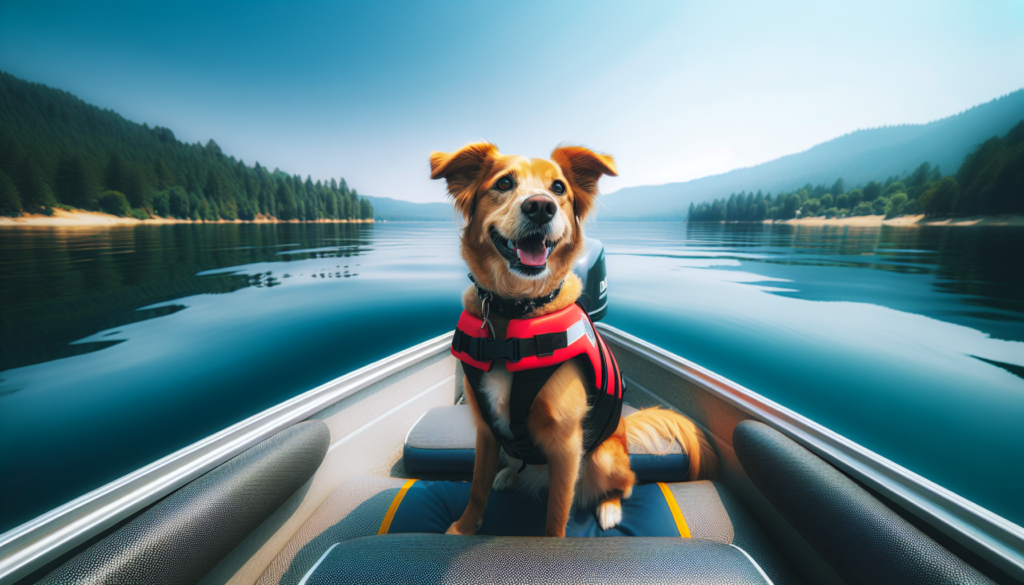Imagine a day sailing leisurely over turquoise waters, lounging beneath sapphire skies, your faithful four-legged companion by your side. “Boating Safety for Pets Onboard” transforms this dream into a reality in the safest, friendliest manner possible for your furry friends. It explores the fascinating and vital world of pet safety during boating adventures, offering insight and advice catering to more than just your human passengers. It ensures that your voyages provide a wholesome experience for all parties aboard, including the ones with paws and whiskers!

Understanding the Importance of Pet Safety Onboard
When it comes to taking your furry friends along on your maritime adventures, understanding the importance of pet safety onboard is crucial. Animals, much like humans, are susceptible to a series of risks while they’re out sailing the azure waters. ensuring their safety allows for memorable and enjoyable experiences instead of stressful ones.
Factors contributing to pet accidents on boats
There is a myriad of factors that contribute to accidents involving pets on boats. Slippery surfaces can lead to injuries, as can unsecured objects that can move and potentially harm your pet when the boat is in motion. Furthermore, pets can easily fall overboard, especially if they’re not accustomed to the constant motion and uneven surfaces of boating environments.
Effects of not observing pet safety
Not observing pet safety while boating can have severe consequences. Pets can get lost, injured, or even die from accidents. Plus, it can be traumatizing for them to cope with such a disruptive and dangerous environment without adequate preparation and safety measures. Proactive planning is the key to avoiding such heartbreaking incidents.
Essential Pre-Boating Preparations for Pets
Embarking on a boating voyage with your pets can be fulfilling, but it calls for meticulous preparation. Your pets will need a clean bill of health, the right training, and the appropriate gear to ensure their safety on the water.
Health and fitness considerations for pets before boating
Ensure your pets are in good health before venturing out onto the water. Make a visit to the vet to ensure they are up-to-date with vaccinations and are physically fit for the adventure. Also, apply pet-friendly sunscreen to protect them from sunburn.
Necessary training for pets before boating
Before letting your pets lose aboard, ensure they’re trained appropriately. This includes easing them into the boating environment gradually, acquainting them with the boat while it’s docked, and giving them time to adjust to the movement while on calm waters.
Getting the right pet gear for boating
Investing in the right gear for your pets is essential for safety. Basic items may include a pet personal flotation device, a first-aid kit, a leash, and portable water and food bowls.
Choosing the Right Pet Personal Flotation Device
Just like humans, pets should have their own personal flotation devices (PFDs) when onboard.
Types of pet personal flotation devices
There are various types of PFDs available for pets. Some feature handles that make it easier to pull your pet out of the water, while others have additional padding to keep your pet warm if adventure calls during cooler months.
Fitting and using pet personal flotation devices properly
It’s crucial to ensure your pet’s PFD fits properly. A PFD that’s too loose might slip off, while one that’s too tight can be uncomfortable. Ensure you Know how to put it on and take it off effectively and that your pet is comfortable while wearing it.
Care and maintenance of pet personal flotation devices
After purchasing a PFD, proper care and maintenance are vital for its longevity. Rinse the PFD with freshwater after each use and allow it to dry completely before storing it away. Regularly inspect it for any damage or wear.
Creating a Safe Environment Onboard for Your Pets
While boating with pets can be loads of fun, creating a safe environment for them onboard is pivotal.
Restrictions and boundaries for pets on a boat
Create a restriction zone where your pet can stay while the boat is moving to prevent any erratic movement induced accidents. This could be a specific area below deck, in the cabin, or a designated spot on deck.
Ensure the boat is pet-friendly
Remove any poisonous baits, dangerous fishing hooks, or other hazardous items from your pet’s reach. Also, provide a shaded area where your pet can escape the sun and heat.
Dealing with pet motion sickness and anxiety
Some pets might suffer from motion sickness or become anxious while on the boat. Consult with your vet about possible medications or strategies to help keep your pet comfortable.

Proper Pet Hydration and Nutrition While Boating
When out on the water, it’s important to keep your pet properly hydrated and fed.
Keeping pets hydrated during a boating trip
Remember to provide a constant supply of fresh water for your pets. Keep it in a non-spill bowl to avoid mess and wastage. Dehydration can lead to health complications, especially in the heat.
Packing the right food for pets
Ensure you pack enough food for your pet’s needs, along with some snacks for long trips. Packed food should be well-sealed to avoid spoilage.
Timing of feeding and water breaks
Avoid feeding your pet during choppy waters or immediately before a trip to prevent vomiting. Regular water breaks are important, especially during hot weather.
Dealing With Pet Emergencies Onboard
Emergencies can happen at any time while boating, and your pet is not exempt from this. Being prepared can make a huge difference in outcomes.
Common pet emergencies during boating
Common emergencies can include overboard falls, injuries from moving objects or fish hooks, and heatstroke. Being aware of these risks and how to handle them can save your pet’s life.
First aid for pets onboard
A pet-specific first aid kit is crucial. It should include items like pet-friendly antiseptics, bandages, tweezers, and a pet thermometer. Knowing basic pet first aid can also be hugely beneficial.
Knowing when to call a vet
In some instances, vet attention may be required. If your pet is not showing signs of recovery after an incident or is in visible distress, it’s important to seek professional help promptly.
The Do’s and Don’ts of Bringing Pets Onboard
Bringing your pet onboard can be a thrilling experience, but there are certain dos and don’ts to observe.
What to do during a boating trip with pets
Always secure your pet while the boat is in motion, take regular breaks for them, and offer constant reassurance. Most importantly, never leave your pet unattended.
What not to do during a boating trip with pets
Avoid feeding your pet while the boat is in motion. Never allow your pet to drink seawater as it can lead to dehydration and sickness.
Training Your Pet for Boating Etiquette
Boating etiquette isn’t just for people; pets need to adhere to rules and behaviors too.
Basic boating commands for pets
Training your pet to understand basic commands like “stay,” “sit,” “come,” and “down” is essential while boating. These commands can help prevent accidents and ensure safety.
Toilet training for pets on a boat
Training your pet to use specific areas for toilet needs is a crucial part of boating etiquette. It helps keep the boat clean and prevents the spread of bacteria.
Desensitizing pets to boat noise and movements
Regular exposure to the boat’s environment can help your pet adapt to the noise and movements. This is vital for preventing panic and nervousness in your pet.
Proper Pet Care After Boating
After a day out on the water, it’s crucial to inspect your pet and provide proper care to ensure they’ve not suffered any injuries or ill effects.
Important post-boating pet checks
Check your pet’s skin for any signs of sunburn or injury, look in their ears for trapped water which could cause infections, and examine their paws for any cuts or wounds.
Cleaning and grooming pets post boating
Wash your pet with a gentle, pet-appropriate shampoo to remove salt, sand, and other residues. Brush their fur to remove tangles and prevent matting.
Health checks after a boating trip
Monitor your pet closely for any signs of distress, lethargy, vomiting, or other signs of illness following your trip. If your pet seems “off” or unwell, contact your vet as soon as possible.
Pet Boating Laws and Regulations
Being aware of the legalities surrounding pets on boats is important to ensure you abide by local laws and regulations.
Knowing your local pet boating laws
In certain regions, laws exist regarding pet safety while boating. These can range from requiring pet life jackets to leash laws. Research your local regulations before embarking on your trip.
Understanding boating etiquettes for pets in popular spots
In popular boating areas, there may be additional rules and etiquettes concerning pets. It’s your responsibility to understand these and adhere to them.
Penalties for not adhering to pet boating laws
Failure to comply with pet boating laws may result in penalties, ranging from fines to bans from certain areas. Ensuring you know and understand the laws will help prevent such consequences.
Bringing your pet along for your boating adventures can be a unique and rewarding experience, but ensuring their safety should always be your primary concern. With proper knowledge, preparation, and care, your maritime adventure with your furry friend will be as smooth as the serene water you set sail on.

